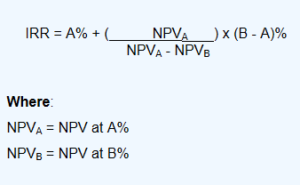Read More
- Introduction to Cost and Management Accounting
- High/Low and Linear Regression Analysis
- Inventory Management
- Accounting for Inventory
- Accounting for overheads
- Absorption Costing
- Marginal Costing
- Job Batch and Service costing
- Process Costing
- Target Costing
- Variances
- Standard Costing
- Cost Volume Profit analysis
- Relevant costing and Decision-Making Techniques
- Time Value of Money (TVM)
Time Value of Money Overview
Discounted cash flow analysis
- It is a technique for evaluating the proposed investments to decide whether thy are financially worthwhile.
- The expected future cash flows (inflows/outflows) from the investment are all converted to a present value by discounting them at the cost of capital ‘r’
- Taking into account the concept of relevant cost.
- It is usually assumed that cash flow early during a year should be treated as a cash flow as at the end of the previous year.
Present value Formulas
Discount factor = 1/(1+r)n
where
r = cost of capital
n = number of periods
Annuity factor = ( 1 – (1+r)-n /r)
Discounted Cash Flow
Time Value of Money
Methods of Discounted Cash Flow

Net Present value (NPV)
- In Net present value (NPV) analysis, all future cash flows from a project are converted into a present value.
- NPV is the difference between present value of all costs incurred and present value of all benefits received.
Approach
- List all cash flows from the project (initial investments, future cash inflows/outflows).
- Discount these cash flows to present value using ‘cost of capital’ as discount rate.
- If present value of Benefits exceeds the present value of costs, the NPV is positive and if present value of benefits is less, then NPV is negative.
- A project is worthwhile if NPV is positive.
- The project commences at time ‘0’ where the cash flows are already at present value.
- Changes in working capital included as cash flows. An increase usually at the beginning of the project in time ‘0’ is a cash outflow and reduction is a cash inflow.
- It is the discounted rate of return on investment.
- It is the average annual investment return from the project.
- The NPV of the projected cash flows is ‘zero‘ when those cash flows are discounted at IRR.
- A company might establish the minimum rate of return that it wants to earn on an investment:
-
- If a project’s IRR is equal or higher than minimum acceptable rate of return, it should be undertaken.
- If IRR is lower than the minimum required return, it should be rejected.
- The following step are involved for calculation of a reliable Internal rate of return (IRR):
-
- Calculate NPV of the project at TWO different rates. One of the NPV should be positive and the other should be negative.
- Put the NPVs in the formula:

Discounted Cash Flow and Inflation
Time Value of Money
Methods of incorporating Inflation

Real cash flows
- The cash flows expressed in today’s price terms.
- They ignore the expectations of inflation.
- In order to incorporate real cash flows in NPV calculation, real cash flows should be discounted at the real cost of capital.
The following steps are involved:
- Calculate real discount rate
= money cost of capital – 1
inflation rate
- Calculate net cash flows at today’s prices.
- Discount them using real discount rate.
This is the most common method used.
- Money (nominal) cash flows are cash flows that include expected inflation.
- Money cash flows should be discounted at the money cost of capital.
The following steps are involved:
- Calculate net cash flows at today’s price.
- Make adjustment for inflation (by doing this they will be converted into money cash flows).
- Use money cost of capital as discount rate.
*Both approaches give same solution, with a difference of rounding off.

Leave a Reply
You must be logged in to post a comment.